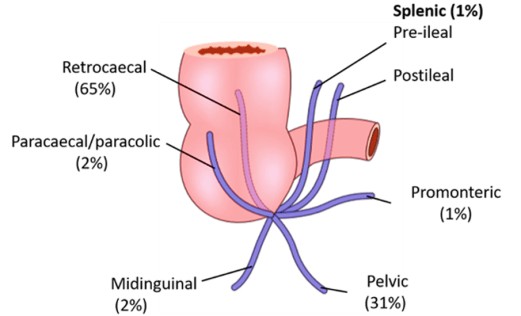INTRODUCTION
The appendix is a narrow blind end attached to the posteromedial end of the dark intestine. It contains a large amount of lymphoid tissue, but is not believed to have vital functions in the human body.
Image source

STRUCTURE AND RELATIONS
The appendix comes from a cecum posteromedical perspective. It is supported by the mesoappend, the art of mesentery, which hangs from the terminal ileum of the appendix.
The location of the free end of the appendix is highly variable and can be classified into seven main sites depending on its relationship to the ileum, caecum, or pelvis. The most common strain is retrocecal. They can also be remembered for their relationship to the dial:
.jpeg)

Pre-ileal - in front of the terminal ileum - 1 or 2 'clock
After Ileal - behind the terminal ileum - 1 or 2 'clock
Ilealeal - in parallel with the terminal ileum - at 3 o'clock
Hip landing over the pelvic edge - 5 o'clock.
Subcecal - below the cecum - at 6 o'clock.
Paracecal - next to the side edge of the small intestine - 10 a.m.
Retrocecal - behind the cecum - 11 o'clock
BLOOD SUPPLY
Arteries are fed from the appendicular artery (derived from the ileocolic artery, the branch of the upper mesenteric artery) and the veins are emptied through the corresponding appendicular vein. Both are included in the Mesolithic.
.jpeg)
NERVE DELIVERY
The sympathetic and parasympathetic branches of the autonomic nervous system innervate the increase. This is achieved with an ileo coin of the upper mesenteric plexus. It follows the ileol artery to reach the appendix.
Note: Clinically relevant, sympathetic afferent fibers in the appendix are due to spinal cord T10 - which explains why visceral pain in early appendicitis is felt centrally in the abdomen
LYMPHATIC DRAINAGE
Lymph fluid from the fluid flows to the lymph nodes in the mesoappendex and to the ileolocular lymph nodes (which surround the ileolar artery).
.jpeg)
CLINICAL CORRESPONDENCE
Inflammation of the appendix is known as appenditis and is a common cause of acute severe abdominal pain. In the established appendix, the abdomen is most sensitive at McBurney - located a third of the distance from the right upper anterior hip joint to the navel. This corresponds to the position of the bottom of the insert when it is in the retrocecal position.
The etiology of appendicitis depends on age. In adolescents, it is mainly due to an increase in the size of the lymph tissue, which closes the cavity. From the age of 30, it is probably blocked due to faecolith.
Originally, the appendix and its visceral peritoneum refer to the umbilical cord. As the appendix becomes more inflamed, it irritates the parietal peritoneum, causing the pain to localize to the right lower quadrant.
If the appendix is not removed, it can become necrotic and tear, leading to peritonitis (inflammation of the peritoneum)